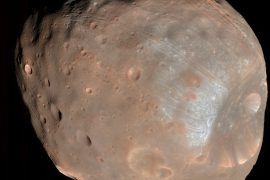-

FromTim Vincent Dickey
To close
-

Tanya Banner
To close
An abandoned rocket booster soon hits the Moon. But does it actually come from SpaceX? The component’s discoverer admits a mistake.
Update from Sunday, February 13th, 2022 at 10:51 pm: This news has been making headlines for some time now: the rocket stage of the “Falcon-9” rocket released from private space company SpaceX is sprinting into space and on a collision course with the Moon. However, it has now been found that this report is false.
Although a rocket component is moving in orbit around the Moon, it is not a SpaceX rocket stage. It is highly likely that the platform comes from China. American researcher Bill Gray, who wrote the message about the Elon Musk rocket, has admitted a mistake on his website.
Rocket on collision course with Moon: Object incorrectly identified as SpaceX rocket
Gray explained that in 2015 he and other observers spotted an unidentified object in the sky and gave it a tentative name: WE0913A. In February 2015, a SpaceX rocket carried the Deep Space Climate Observatory (DSCOVR) satellite into Earth orbit. According to Gray, further observations have indicated that the find must have been a man-made object. The second “Falcon 9” rocket stage soon became the most likely candidate.
Not SpaceX, but China: A “Long March” rocket is on its way to impact with the Moon. (archive image)
© Guo Cheng / DPA
However, NASA researcher John Giorgini took a closer look at Gray’s observation and concluded that the SpaceX rocket could not have made it to orbit at all. He informed Bill Gray of his discovery in an email on Saturday (February 12, 2022), which reports on his website.
But not SpaceX: Chinese rocket component is about to hit the Moon
“Inspired by John’s email, I dug through my email archive to remember why I originally identified the object as DSCOVR level seven years ago,” wrote Bill Gray. Even when he searched his archives, he was completely convinced that he had made no mistake. But Gray also noticed discrepancies upon closer inspection.
The American researcher researched his data and found that part of the rocket must have been the booster of a Chinese “Long March 3” rocket, which was used in the Chang’e 5-T1 moon mission. The timing of the launch and the lunar orbit almost exactly coincide with the orbit of the object that will hit the Moon in March. According to Gray’s calculations, the Chinese booster will hit the surface of the Moon on March 4.
Although the new discovery is only circumstantial, Bill Gray is still convinced that the object must be a Chinese rocket component. The researcher spoke of “quite convincing evidence”.
SpaceX rocket out of control: Impact on the Moon is imminent
First report from Tuesday, January 25, 2022: Frankfurt – If a rocket is launched into space, it’s usually no longer interesting after a few minutes – after all, it’s just the transporter and it has served its purpose: a space travel– Missions on your way. At SpaceX, the private space company of billionaire Elon Musk, the rocket’s first stage remains relevant after launch: it usually takes off on an autonomous ship or land and is ready for the next rocket launch. But for the second rocket stage, the adage “out of sight, out of mind” usually applies.
No wonder: the second rocket stage is usually caused by accidental burns in Earth’s atmosphere. But a rocket stage launched by SpaceX in 2015 is suddenly gaining attention again. In February 2015, a SpaceX Falcon 9 rocket carried NOAA’s Deep Space Climate Observatory (DSCOVR) satellite into space. It was the first SpaceX interplanetary rocket launch to carry its cargo out of Earth orbit.
SpaceX rocket stage on collision course with Moon
As the NOAA satellite began its journey known as the Lagrange point, more than one million kilometers from Earth, the rocket’s second stage ran out of fuel to propel it into Earth’s atmosphere to burn. And it also lacked the energy to escape the gravity of the Earth and the Moon.
And so it is that a SpaceX rocket stage has been falling into a chaotic orbit through the Earth-Moon system since February 2015. But the object’s fate is now clearly sealed: A new calculation suggests that its orbit puts the abandoned object on a collision course with the Moon. Bill Gray, who developed the software used by professional and amateur astronomers around the world to observe near-Earth objects, asteroids and comets, believes SpaceX will land on the Moon in early March. The rocket must have an uncontrolled impact.
SpaceX rocket stage wobbles uncontrollably toward the Moon
Because the rocket stage appears to wobble in its orbit, Gray called off observations a while back to get more data. Using this new data, Gray expects the Falcon 9 rocket stage to hit the far side of the Moon near the equator on March 4, 2022.
What is happening in space? What topics drive space travel, what research is done in astronomy? Subscribe to the FREE FR newsletter and stay up to date.
However, there are still uncertainties as “space junk can be a bit tricky”, As Gray writes on his website, Gray explains that how sunlight affects the object is “difficult to predict completely.” “The unexpected effects are very small, but they will add up between now and March 4th,” the researcher continues.
Space Exploration: SpaceX Rocket Stage to Hit Moon in March 2022
Gray wants to predict the impact of rockets on the Moon as accurately as possible to enable research into the effect. The lunar orbiter “Lunar Reconnaissance Orbiter” (LRO) from NASA and “Chandrayaan-2” from India can find the resulting crater on the lunar surface and perhaps even observe the impact. As of now, Gray fears his prediction may be off by several minutes, with further comments expected in February that could reduce uncertainty.
Space: SpaceX rocket stage likely to leave impact crater on Moon
If a SpaceX rocket stage does hit the Moon, Gray believes it will be the first accidental impact of space debris on the Moon. In October 2009, the US space agency NASA intentionally launched the Lunar Crater Observation and Sensing Satellite (LCROSS) spacecraft to gain scientific knowledge of the impact on the Moon. Earlier, the probes that were supposed to land had already hit the Moon. NASA’s “Apollo” mission also intentionally dropped parts of the spacecraft on the Moon.
The impact of the upcoming rocket stage on the Moon is “essentially a free LCROSS,” writes Gray. However, you probably won’t see the impact, as it’s likely to be behind the Moon. “If we can tell the LRO and Chandrayaan people where the crater is, they can see a very fresh impact crater at that location and potentially learn about the geology of this part of the Moon,” Gray conjectures. Put it. After all, we know the mass of an empty Falcon 9 second stage – four tons – and the speed at which it will hit – 2.58 km/s (about 9300 km/h). (tab)
SpaceX is repeatedly criticized for its “Starlink” satellite group: a recent study showed that satellites primarily affect astronomy during the evening hours – and this is what makes them potentially dangerous. Important for the search for near-Earth objects. The environmental impact of countless rocket launches is also discussed.
List of Rubrics: © Guo Cheng/DPA

Internet fan. Alcohol expert. Beer ninja. Organizer. Certified tv specialist. Explorer. Social media nerd.





